Nothing lasts forever, but I wish we could have at least met them.— scholar
The second school, then, is the most obvious: through some means or another, the Feidísfolk were destroyed. It would not be an uncommon fate anywhere on Iskaldhal; indeed, many attempted colonies have either met with similar ends or have fled to neighbouring settlements. The establishments of nations like
Volkur is largely due to luck and magical strength rather than their own preparedness for the devastation Iskaldhal can bring.
Chief among these theories is the theory of natural disaster. Magical leystorms, caused by the rise of
arcane magic, were not present prior to the Second Divine War, but their absence did not lessen the impact of winter storms. A sufficiently strong storm could have collapsed their settlements, ruined their fields, and starved the population - even with the aid of druidic magic and fey trickery to summon food and protection. Equally, Iskaldhal is prone to volcanic activity and earthquakes, either of which could have caused conditions inhospitable to life in the Feidísfolk's lands.
They may also have fallen foul of Iskaldhal's many other inhabitants. Though no extant Iskaldhan civilisation, like the ever-ancient
Gildómar, holds records of a war against the Feidísfolk, there were many other nations that rose and fell. One such group may have taken issue with the Feidísfolk or may have sought their land, and they may have been destroyed in the warfare that ensued.
The
Shrines of Stone had also been built prior to the Feidísfolk's time, and due to their proximity to at least the Eastern Diamond Shrine, there is significant potential for them to have been captured within the Shrine or otherwise taken (alive or dead) by the
dragons reigning over much of Iskaldhal. Whilst most other theories would at least leave trace for archaeologists to eventually find, this would explain the utter lack of such.













So nostalgic and beautifully written. I love that there are scraps of tapestries still surviving. My little crafter heart was so happy at that.